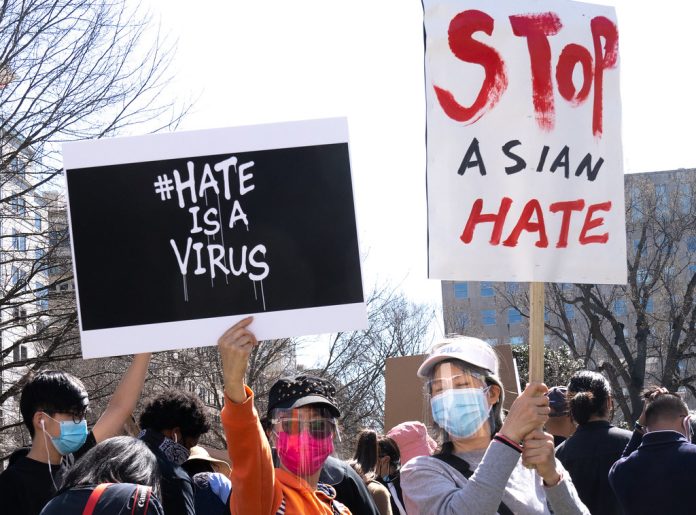Felix Dong
Staff Writer & Photographer
Over the course of the last year, during the COVID-19 pandemic, hate crimes and violence against Asian Americans skyrocketed. Many victims are parents, siblings, grandparents, colleagues, friends, and community members who have a huge impact on their families and communities.
Cal State East Bay’s Center for the Study of Hate and Extremism revealed that anti-Asian hate crimes increased by 339 percent across the U.S. last year. Hate crimes have traumatized the Asian American community, many fearing for themselves and their family members and being afraid to go outside.
Christina Yuna Lee, a senior creative producer at Splice, was a “bubbly, curious, creative and confident human [who] made you feel heard and accepted and warm,” as described by her manager and co-workers. Kenneth Takanami, a colleague of Christina, talked about how they came together to support their colleagues shortly after the murder of six Asian women in Atlanta. Paul Park, a family friend, called Christina, his older sister, and remembered how they celebrated Thanksgiving just a few months ago. On Feb. 13, Christina Yuna Lee climbed up six flights of stairs into her apartment building where she was then murdered. Just a few weeks earlier, another woman in New York City, Michelle Go, was pushed onto subway train tracks.
It is easy to feel distant from these incidents, which could be seen as isolated, especially at a more diverse university like UC Santa Barbara (UCSB). Historically, however, that is not the case.
One incident happened in San Rafael Residence Hall. On April 7, 1990, Jacob Sarvela attacked Tom Tieu, an Asian American student, who suffered multiple contusions to the face – one requiring stitches – and a broken nose. He spent days hiding in his room, fearful of a repeated assault from Sarvela.
UCSB graduate Helen Quan, the organizer of the rally, pointed out how “we can’t rule the possibility out […] [that the assault of Tom Tieu] coincided with anti-Asian incidents across the country.” In 1989, one year prior, a white gunman killing five and wounding 29 children at the Cleveland Elementary School Shooting and the brutal murder of Jim Ming Hai Loo were just two instances that greatly shook the Asian American community.
In April 2009, The Bottom Line (TBL) reported that third-year student Thanh Hong and his friend were walking home passing by the PIKE fraternity house when one individual “began shouting at Hong and his friend. After the two ignored him, the individual allegedly came up to Hong and his friend and pushed them from behind. The assailant allegedly began making racial slurs such as ‘ch***-ch***-ch***’ and ‘g**k’ and proceeded to punch Hong’s friend in the face.”
In the Daily Nexus, Winston Chou wrote an opinion piece responding to how the leadership of the fraternity fails to note the historical implications of racial slurs and have “historically implied, merely on the basis of our skin, that minorities warrant hatred, contempt, fists to our bloodied faces and worse.”
Violence and racism against Asian Americans still continue to affect students and the larger community even today. Earlier this month, the UCLA Asian-American Studies department received a flyer including racist messages detailing a white supremacist rally. Looking back at these news articles, student writers and activists continually call for readers to recognize that anti-Asian incidents continue to happen and that it deeply wounds the Asian American community. To write this article a little over a decade later shows that there is still much work to be done to address anti-Asian hate and racism.
These incidents not only affect Asian American students but other marginalized communities as well. Throughout UC Santa Barbara’s history, students have come together to advocate for change, one of the many examples being the Hunger Strike in 1989 that led to the building of the Multicultural Center.
During the winter quarter of 2020, students and faculty came together in support of a Cost-to-Living-Adjustment (COLA) for UC graduate students who faced rising rent prices and insecurity. During the spring quarter of 2020, students came together to participate in the Black Lives Matter protests and show support for Black students and faculty. It means coming together to support each other and advocate for change to support future generations of our UC Santa Barbara community.
We cannot keep hearing these names on the news, sending our prayers, and continuing this cycle. Contact your representatives. Attend rallies and vigils. Donate money to community organizations. Volunteer with a community organization, like Compassion in Oakland, a volunteer organization that provides chaperones for elderly Asian Americans walking around town or walking home late at night.
Most importantly, spread awareness and talk about what is happening. We cannot be desensitized to the news and give up as if hate crimes will eventually disappear. We must talk about racism and address it, however uncomfortable it may be. These uncomfortable conversations mean addressing our own internal bias, vulnerabilities, and trauma but are also an opportunity for us to come together as a community.











